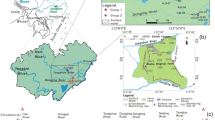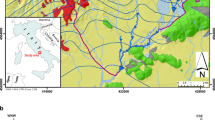Abstract
Deep groundwater aquifers are used as freshwater resources in many parts of the world. Because of overuse, increase in salinity, natural and human-driven contamination, sustainability of these aquifers is uncertain. The purpose of this study is to better understand the groundwater flow system in a deep bedrock aquifer in northern Illinois, and its effect on the radium transport in the town of Rochelle’s Public Water Supply Wells (PWSW). Six bedrock hydrostratigraphic units are identified: the Maquoketa Shale, the Galena–Platteville Dolomite, the St. Peter Sandstone, the Potosi–Franconia Dolomite, the Ironton–Galesville Sandstone, and the Eau Claire Shale. We tested two hypotheses: (1) Radium (Ra) transport is driven by large pumping centers that interrupt groundwater flow (groundwater divide) and direct elevated level of Ra from areas that have already recorded Ra to PWSW and (2) Increased pumping results in flow of water from the Franconia Formation (lumped with Potosi formation hence referred to as Potosi-Franconia) has Ra-bearing glauconite into the PSWS that is opened to the Ironton–Galesville aquifer. Hypotheses were tested by building a 3D steady-state numerical groundwater model using MODFLOW, MODPATH, and Stochastic Models. The numerical model was calibrated using in-situ groundwater level measurement data and virtual observation head data obtained from the Illinois Groundwater Flow Model (IGWFM), with Mean Error (ME), Root Mean Squared Error (RMSE), and coefficient of determination (R2) values of 0.07 m, 1.74 m, and 0.991, respectively. Using the calibrated model, scenario models, stochastic, capture zone analysis, and mass balance were conducted. The results indicated that the large pumping centers have less control on the shift in regional groundwater divide, hence preventing flow of radium rich waters to Rochelle’s PWSW. On the other hand, capture zone results and mass balance show flow from the Potosi–Franconia Formation into the Ironton–Galesville aquifer which might indicate the source of radium being upgradient into the PWSW. In general, it is recommended to tap water from shallower bedrock aquifers located above the Potosi–Franconia Formation as a way of mitigating elevated level of radium in the water supply wells.












Similar content being viewed by others
References
Abrams, D.B, Hadley DR, Mannix DH, Roadcap. S, Meyer CS, Hinka KJ, Rennels KL, Bradbury R, Chase MP, Krause JJ (2015) Changing groundwater levels in the sandstone aquifers of northern Illinois and Southern Wisconsin: impacts on available water supply. In: Survey ISW (ed), Champaign
Abrams DB, Mannix DH, Hadley DR, Roadcap GS (2018a) Groundwater flow models of Illinois: data, processes, model performance, and key results. Illinois State Water Survey, Champaign
Abrams DB, Roadcap GS, Mannix GH, Hadley DR (2018b) The Illinois groundwater flow model. In: Survey ISW (ed), Champaign
Antonellini M, Aydin A (1994) Effect of faulting on fluid flow in porous sandstones: petrophysical properties1. AAPG Bull 78:355–377. https://doi.org/10.1306/bdff90aa-1718-11d7-8645000102c1865d
Ayotte JD, Szabo Z, Focazio MJ, Eberts SM (2011) Effects of human-induced alteration of groundwater flow on concentrations of naturally-occurring trace elements at water-supply wells. Appl Geochem 26:747–762. https://doi.org/10.1016/j.apgeochem.2011.01.033
Burch SL (1991) The new Chicago Model: a reassessment of the impacts of Lake Michigan allocations on the Cambrian–Ordovician aquifer system in Northeastern Illinois. Illinois State Water Survey, Champaign
Cullen DJ (1978) The uranium content of submarine phosphorite and glauconite deposits on Chatham Rise, east of New Zealand. Mar Geol 28:67–76. https://doi.org/10.1016/0025-3227(78)90017-8
Fitts CR (2013) 1 - Groundwater: the big picture. In: Fitts CR (ed) Groundwater Science, 2nd edn. Academic Press, Boston, pp 1–22
Greer CB (2009) Recharge analyses into shallow glacial and depp bedrock aquifers related to the Troy Bedrock Valley system, DeKalb County, Illinois. Geological Society of America Abstract with Programs, Portland, p 213
Hadley DR, Abrams DB, Roadcap GS (2020) Modeling a large-scale historic aquifer test: insight into the hydrogeology of a regional fault zone. Groundwater 58:453–463. https://doi.org/10.1111/gwat.12922
Harbaugh AW (2005) MODFLOW-2005 : the U.S. Geological Survey modular ground-water model: the ground-water flow process, vol 6. US Department of the Interior, US Geological Survey, Reston
Hunt RJ, Feinstein DT (2012) MODFLOW-NWT–robust handling of dry cells using a Newton formulation of MODFLOW-2005. Ground Water 50:659–663. https://doi.org/10.1111/j.1745-6584.2012.00976.x
Kelly, W.R. (2008) Radium and barium in the Ironton–Galesville bedrock aquifer in northeastern Illinois. In: Center for groundwater science report. Illinois State Water Survey, Champaign, p 36
Kolata DR, Buschbach TC, Treworgy JD (1978) The Sandwich Fault Zone of northern Illinois. Urbana, Illinois State Geological Survey, p 26
Kolata DR, Graese AM (1983) Lithostratigraphy and depositional environments of the Maquoketa Group (Ordovician) in northern Illinois. Illinois State Geological Survey, Prairie Research Institute, Champaign, p 49
Kolata DR, Nimz CK (2010) Geology of Illinois. Illinois State Geological Survey, Champaign
Mahmud K, Mariethoz G, Baker A, Sharma A (2015) Integrating multiple scales of hydraulic conductivity measurements in training image-based stochastic models. Water Resour Res 51:465–480
Mandle RJ, Kontis AL (1992) Simulation of regional ground-water flow in the Cambrian–Ordovician aquifer system in the northern Midwest, United States: in regional aquifer-system analysis. US Geological Survey, Reston
Mannix DH, Abrams DB, Hadley DR, Roadcap GS (2019) Conceptualizing leakage and storage contributions from long open interval wells in regional deep basin flow models. Hydrol Process 33:271–282. https://doi.org/10.1002/hyp.13324
McDonald MG, Harbaugh AW (1984) A modular three-dimensional finite-difference ground-water flow model. US Geological Survey, Reston
Pollock DW (2016) User guide for MODPATH Version 7—A particle-tracking model for MODFLOW. Reston, US Geological Survey, p 41
Rayne TW, Bradbury KR, Zheng C (2014) Correct delineation of capture zones using particle tracking under transient conditions. Groundwater 52:332–334. https://doi.org/10.1111/gwat.12141
Roadcap GS, Meyer SC, Kelly WR, Wehrmann HA, Lin YF (2013) Groundwater studies for water supply planning in Kendall county. Illinois, Illinois State Water Survey, Champaign
Seid MJ (2010) Bedrock geology of Oregon Quadrangle, Ogle County, Illinois. Illinois State Geological Survey USGS STATEMAP contract report, Champaign
Şengör SS, Ünlü K (2013) Modeling contaminant transport and remediation at an acrylonitrile spill site in Turkey. J Contam Hydrol 150:77–92. https://doi.org/10.1016/j.jconhyd.2013.02.010
Seyoum WM, Eckstein Y (2014) Hydraulic relationships between buried valley sediments of the glacial drift and adjacent bedrock formations in northeastern Ohio, USA. Hydrogeol J 22:1193–1206. https://doi.org/10.1007/s10040-014-1128-y
Stackelberg PE, Szabo Z, Jurgens BC (2018) Radium mobility and the age of groundwater in public-drinking-water supplies from the Cambrian–Ordovician aquifer system, north-central USA. Appl Geochem 89:34–48. https://doi.org/10.1016/j.apgeochem.2017.11.002
Szabo Z, dePaul VT, Fischer JM, Kraemer TF, Jacobsen E (2012) Occurrence and geochemistry of radium in water from principal drinking-water aquifer systems of the United States. Appl Geochem 27:729–752. https://doi.org/10.1016/j.apgeochem.2011.11.002
Visocky AP, Sherrill M, Cartwright K (1985) Geology, hydrology, and water quality of the cambrian and ordovician systems. In: Survey ISG (ed) Champaign. IL
Weaver TR, Bahr JM (1991) Geochemical evolution in the Cambrian–Ordovician sandstone aquifer, eastern Wisconsin: 2. correlation between flow paths and ground-water chemistry. Groundwater 29:510–515. https://doi.org/10.1111/j.1745-6584.1991.tb00542.x
Yidana S (2011) Groundwater flow modeling and particle tracking for chemical transport in the southern Voltaian aquifers. Environ Earth Sci 63:709–721. https://doi.org/10.1007/s12665-010-0740-y
Yu C, Kamboj S, Wang C, Cheng J-J (2015) Data collection handbook to support modeling impacts of radioactive material in soil and building structures. In: Division ES (ed) Argonne National Laboratory. Chicago
Zapesca OS, Szabo Z (1988) Natural radioactivity in ground water-a review. National water summary 1986–hydrologic events and ground-water quality. Water-supply paper 2325. U.S. Geological Survey, Reston, pp 50–57
Zhou Y, Li W (2011) A review of regional groundwater flow modeling. Geosci Front 2:205–214. https://doi.org/10.1016/j.gsf.2011.03.003
Funding
The authors have not disclosed any funding.
Author information
Authors and Affiliations
Corresponding author
Ethics declarations
Conflict of interest
The authors declare that they have no conflict of interest.
Additional information
Publisher's Note
Springer Nature remains neutral with regard to jurisdictional claims in published maps and institutional affiliations.
Rights and permissions
Springer Nature or its licensor holds exclusive rights to this article under a publishing agreement with the author(s) or other rightsholder(s); author self-archiving of the accepted manuscript version of this article is solely governed by the terms of such publishing agreement and applicable law.
About this article
Cite this article
Oware, P., Seyoum, W.M., Malone, D.H. et al. Groundwater flow path and travel time using numerical models to understand radium transport in deep bedrock aquifers. Environ Earth Sci 81, 463 (2022). https://doi.org/10.1007/s12665-022-10580-w
Received:
Accepted:
Published:
DOI: https://doi.org/10.1007/s12665-022-10580-w




